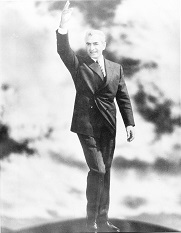
 | International House of Mashruteh |
On February 26, 1963, the six charters of the Shah and Mardom were put to a referendum, and the people of Iran went to the polls with unparalleled enthusiasm and answered yes to this referendum. On this day, Iranian women voted for the first time. The people of Iran, by an overwhelming majority of more than five million and five hundred thousand votes, approved the Charter of Shah and Mardom Revolution.
In his speech at the Grand National Congress commemorating the beginning of the second decade of the Shah and the people's revolution, His Imperial Majesty gave new instructions and instructions on the way to advancing and completing the Iranian revolution, which will henceforth be called the "Shah and Mellat Revolution".
The beginning of the revolution of the Shah and Mardom dates back to 1942, when by royal decree the royal property was distributed among the farmers. Mohammad Mossadegh, one of the largest feudal lords of Iran, during his prime-ministership opposed the land reform, organized opposition and stopped distribution of agricultural lands among farmers, with the support of the National Front and the Tudeh Party. These objections were raised by Mossadegh to such an extent that Mossadegh confiscated the royal property so that the distribution of land in Iran would no longer take place. After the arrest of Mossadegh, Shahanshah Aryamehr pursued a plan of land reform and the abolition of the feudal regime.
With the approval of the law on the sale of agricultural land and its distribution among farmers in 1955, the second phase of land reform began.
The third stage of land reform was incorporated into a broad program of social and economic reform, the Shah and Mardom Revolution, also known as the White Revolution. The Charter of the Six Articles of the Shah and Mardom Revolution changed the social, political and economic principles of Iran overnight. This charter includes land reform (phase 3), nationalization of forests and pastures, sale of shares in state-owned factories to support the land reform, workers' share of factory profits, amendment of Iran's election law to give women the right to vote, and equal political rights to Iranian women and the creation of the Knowledge Corps.
With the approval of the law on the order of consideration and finalizing land reform cases on June 28, 1975 by the Majlis Shora Melli and July 23, 1975 by the Senate, all cases of property distribution had taken place, and official documents had been given to notaries when no complaints or objections had been lodged against them, from the point of view of the implementation of the land reform regulations, it was announced that it was over and the farmers' ownership of their lands were registered and the case was closed forever.
The Shah of Iran Mohammad Reza Shah Pahlavi Ariamehr, one of the greatest human rights fighters, based on the Iranian Constitution and the referendum of 6th Bahman in which the Iranian people approved the Charter of the Shah and Mellat, with the then prime ministers Dr. Ali Amini, Assadollah Alam, Hassan Ali Mansour and Amir Abbas Hoveyda, made radical changes in Iran.
